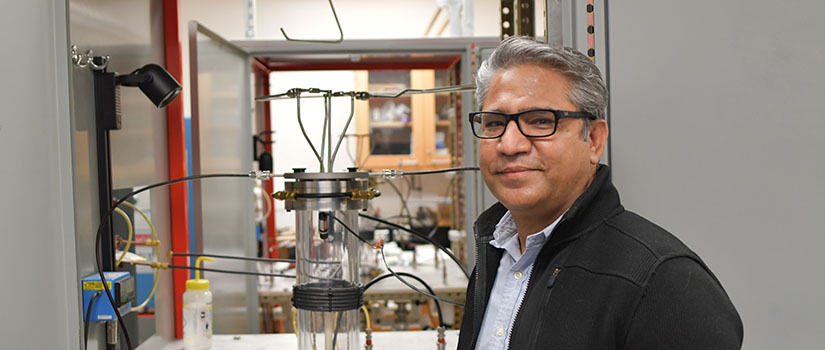Ultraviolet Light Emitting Diodes (UV-LEDs) are widely available and affordable but notoriously inefficient. Past research in UV-LEDs focused on material quality and design, but Electrical Engineering Assistant Professor Iftikhar Ahmad recently began research to increase efficiency by integrating new materials into the LED structures.
Ahmad’s research, “High Efficiency UV-LEDs Based on Hybrid 2D/3D Materials,” started in August and is funded by a $375,000, three-year grant from the National Science Foundation. According to Ahmad, the research aims to design a revolutionary high-efficiency, vertically conducting UV-C LED, which among other uses, can kill viruses, bacteria and molds, purify water, and eliminate germicides.
“The study will focus on creating and integrating hybrid 2D and 3D layer structures in UV-LED that will lead to the replacement of the traditional UV-LED structure and an increase in the efficiency,” Ahmad says. “The current efficiency of UV-LEDs is around 10%. Our research plans to increase the efficiency to 25% to replace presently used technology.”
Due to their higher efficiency, LED lights are increasingly replacing traditional incandescent bulbs and fluorescent tubes. They have various uses and emit different colors of light, from red to violet to ultraviolet, based on the materials used. Their efficiency rate is between 80% to 90%. UV-LED goes through the same process as LEDs to produce light, but their efficiency rate is only between 4% to 10%.
“Our research will see how we can minimize that huge disconnect. Efficiency higher than 25% can change and replace the presently used technology,” Ahmad says. "For example, UV lights remove germs with water purification systems, but you must increase the efficiency if you want to replace it with a UV-LED light for it to be economically viable.”
Aluminum gallium nitride is a 3D material traditionally used for emitting UV light. But Ahmad plans to use the 2D material consisting of boron nitride in the conventional UV-LED structure, with significant internal reflections and absorptions. The use of 2D materials provides several advantages by separating the LED active structure from absorbing inactive structure, including the substrate (underlying layer). The active LED structure is a specific stack of materials atop the substrate, including the quantum well structure, where all LED combinations and emissions occur.
“The use of 2D materials to play multiple roles in the UV-LEDs is unique and technically challenging and has never been envisioned in the same device. Our multi-faceted research aims to reduce absorption and transmission losses and create vertically conducting UV-LEDs. Previous attempts failed to significantly improve the efficiency of UV-LEDs since a single approach was used,” Ahmad says.
Upon completing the structure, it can be easily divided using 2D materials to reduce the absorption of the UV light, resulting in high efficiency.
“When UV light is produced, it has higher tendencies for absorption and internal reflections for the material system used than visible light. I proposed that for UV-LED, you can separate the quantum structure along with contact layers,” Ahmad says. “The quantum structure creates the preferable region for electrons and holes to recombine to produce light. All the light comes from active regions traveling in different directions.”
By separating and modifying the quantum structure, Ahmad believes it can increase UV-LED light emission efficiency from 4-10% to 25-30%. While previous research has attempted to increase light efficiency by separately removing or modifying layers, Ahmad has proposed adding the 2D material to remove the quantum structure and replace the absorbing contact layer with the combination of 2D and 3D materials (aluminum gallium and boron nitride). The combined approach would not only provide a better contact layer but also hold more efficiency.
“Gallium nitride as contact layers for UV-LEDs is usually absorbed, but our simulation and initial results have shown that it can be replaced with aluminum gallium boron nitride non-absorbing contact layers,” Ahmad says. “The preliminary results also show that we can grow boron nitride in the structure, even though it’s grown at a high temperature [1,300 degrees Celsius].”
Ahmad admits that even small, incremental research and improvement can be beneficial for different applications. He hopes his work can improve the current deficiencies of UV-LEDs.
“Some of this research has been done separately. For example, the boron nitride has been grown but not used in the way I am attempting,” Ahmad says. “While the LED structure is not completely new, my research will be an innovative way of how to creatively produce the same wavelength of UV-light but with higher efficiency.”
